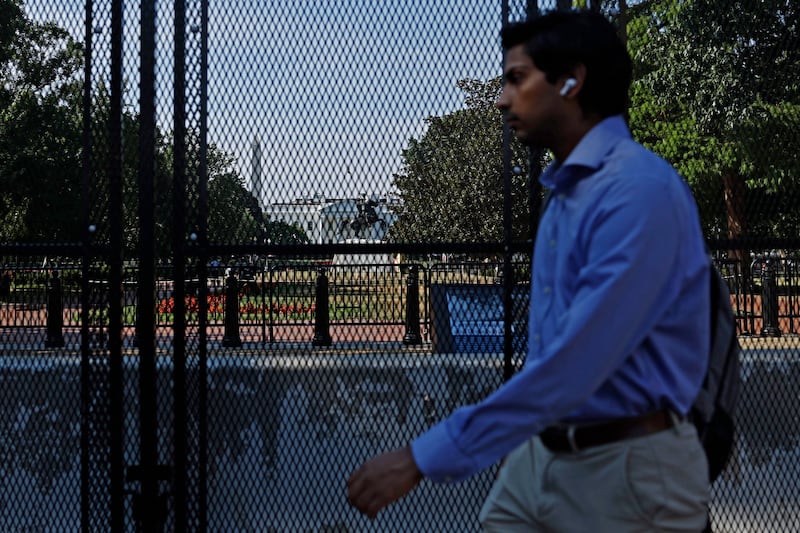World leaders arrived in Washington on Monday to prepare for the Nato summit which marks the 75th anniversary of the foundation of the organisation in the city. For President Joe Biden, the intense three-day conclave offers a welcome respite from the domestic sirens wailing over election nominations while the myriad road closures and security arrangements in place in the city offer a three-day nightmare for taxi drivers and tourists.
Aid for Ukraine’s effort to liberate itself from Russia’s invasion will inevitably dominate the theme and tone of the event. Leaders from the 31 Nato partners will welcome Sweden as the 32nd member of the group and will be joined by Nato partners from Ukraine, Japan, New Zealand, the Republic of Korea and the European Union.
On Wednesday, Biden will host his first bilateral meeting with the new British prime minister, Keir Starmer, whose presence underlines the fact that the turbulence through the various air spaces of the American political sphere is mirrored by what has been an extraordinary period in European politics. The summit coincides with a redrafting of the British political landscape, the continuing upheaval of the snap French election and a German coalition under chancellor Olaf Scholz coming close to the brink over rows about budgetary spending.
The talks will begin on a ceremonial note on Tuesday evening when the president and the first lady, Jill Biden, will host an anniversary event at the Mellon Auditorium on Constitution Avenue, site of the original signing of the Nato-Washington treaty in 1949.
RM Block
As part of his duties as leader of the host nation, Biden will hold an event with Ukrainian president Volodymyr Zelenskiy, along with two dozen allies and partners who have signed bilateral security agreements with Ukraine and will announce new steps to strengthen Ukraine’s air defences. At last year’s summit in Vilnius, Zelenskiy did not disguise his unhappiness at the failure of the Nato allies to provide a clear outline for Ukraine’s membership negotiations. Much of the rhetoric at this summit will seek to highlight the “bridge” proposal that has been agreed.

At an advance briefing on Monday, ambassador Michael Carpenter, senior adviser for Europe at the National Security Council, rejected the suggestion that the Nato leaders were in danger of complacency regarding their aid to Ukraine.
“I’ll take issue with your premise. Go back three months and look at all the dire predictions many of you were making of where we would be at the time of the summit in terms of Ukraine’s standing. Since President Biden signed the supplemental Bill into law in late April… we surged an additional €61 billion in support for Ukraine, rolled out six presidential drawdown packages; there are up to 20 countries that will have signed bilateral security agreements by the time of the summit. Those are 10-year agreements that will help sustain Ukraine’s future force.
“And there is what Nato itself is providing: the Nato security assistance at training Ukraine programme which will stand up an entire command to support Ukraine with training co-ordination, with logistics, with security assistance, with force development, and will be that bridge to membership that will take Ukraine into a position… that when the political will is there for Ukraine to accede to the alliance, Ukraine will be fully ready on day one. I think that is a dramatic trajectory over the course of the last three months as opposed to the dire predictions of where Nato would be, where allies would be.”
Even as the table settings were laid in Washington, news travelled across the Atlantic that at least 35 people had been killed in a Russian missile barrage on Kyiv that included a strike on Ohmatdyt hospital, the largest children’s hospital in the country, and that rescue attempts to locate people under rubble were ongoing. Acknowledging that atrocity, Carpenter stressed that a further air defence announcement was imminent, along with an announcement of F16 military aircraft.
The failure of Nato allies to match US spending was sharply criticised by Donald Trump during and after his term in the White House. This year’s summit will stress that while only nine member countries were spending the agreed 2 per cent of gross domestic product on defence spending when Biden started out in the Oval Office, 23 allies are now spending at or above that level.
But beneath the substance of the talks, the performance of Biden under the glare of international scrutiny will become the recurring subplot of the week, and the attending leaders and ministers will be watching for any discernible clues as to whether he is likely to be the figurehead of US commitment to Nato next year.
“It is the leadership of the US in Nato,” Kurt Volker, the former US ambassador to Nato said on Monday of the real conversations on the margins at this week’s itinerary of events.
“Is it going to be President Biden? Is he capable of that? Is he going to run for re-election? Is he going to get elected? If so, what does that look like? A lot of allies are already concerned about what they see as a lack of willingness to commit to the defeat of Russia in Ukraine. Then, the worry is if he doesn’t do that and it is president Trump coming back, what does that mean for US support for Nato and Ukraine?”
- Listen to our Inside Politics Podcast for the latest analysis and chat
- Sign up for push alerts and have the best news, analysis and comment delivered directly to your phone
- Find The Irish Times on WhatsApp and stay up to date















